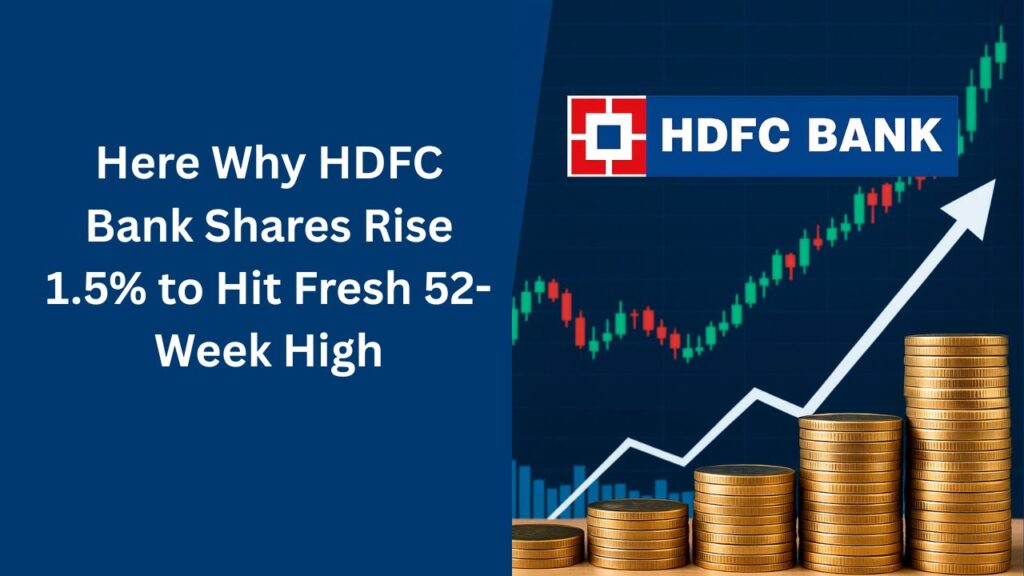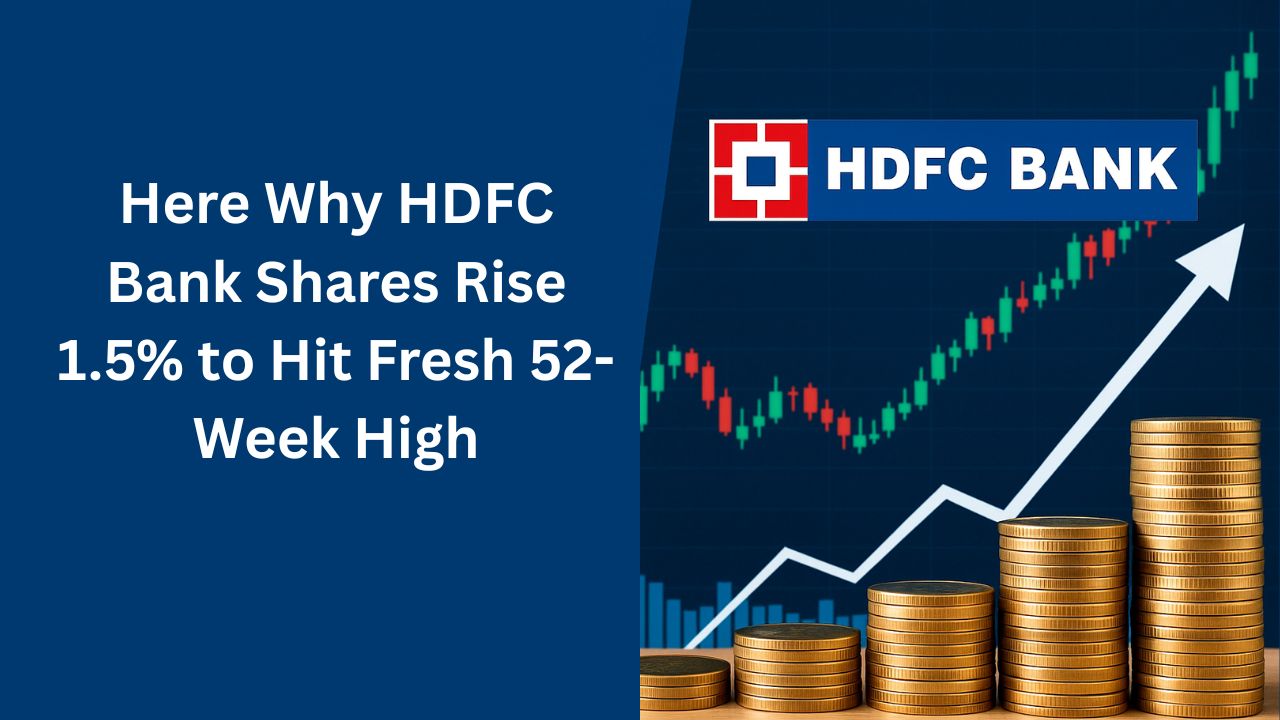HDFC Bank shares rose 1.5% to a new 52-week high of ₹1,996.30 on June 6, 2025. The achievement is attributed to a combination of positive macroeconomic policy, strong investor sentiment and robust confidence in the bank. Let’s take a closer look at some of the catalysts behind this rally, and what it means for investors and the rest of the banking industry.
RBI’s Surprise Rate Cut: The Main Trigger
HDFC Bank posted a sharp rise led by the Reserve Bank of India’s (RBI) surprise decision to cut its repo rate by 50 basis points (bps) to 5.5%.
It was also the second rate cutback to back since February 2025 which had altogether cut the rate by 100 bps within a short period of time. In addition to this, the RBI also declared a much needed 100 bps reduction in the CRR, to be rolled out in four instalments from September 2025.
This action will inject some ₹2.5 lakh crore worth of liquidity into the banking system by December 2025.
This sort of monetary easing is aimed at boosting domestic demand, which would help promote the country’s economy and offset the impact of slowing inflation.
For banks like HDFC Bank, lower interest rates lower the cost of funds, making it easier to lend and grow their loan books. It adds to their ability to lend cheaper at base point rate.

Market Reaction: Banking Shares Surge
The RBI’s policy decisions may have given a fillip across the stock market; especially for the interest rate-sensitive sectors like banking.
HDFC Bank, as one of the largest and most stable Indian private sector lenders, has become a good hunting ground for investors looking to bet on the better loan environment.
Intraday trade mein stock ne 1.53% tak grow kar ke ₹1,996.30 ke level par trade kiya, stock ki adhik volume 89 lakh share (approx) se jyada thi or market capitalisation yeh ₹15 lakh crore ke upar thi.
Technical indicators also lent support to the bullish view. Stock of HDFC Bank was trading significantly above all important moving averages (from 5-day to 200-day), and its 14-day RSI was placed near 65, signaling strong momentum with slightly overbought conditions.
The price-to-earnings (P/E) ratio was a robust 20.42 and price-to-book (P/B) was 3.30, which indicated that investors believe in the bank’s valuation and development potential.
Why Rate Cuts Mean Something for HDFC Bank
Cheaper borrowing Lower policy rates directly help banks lower their costs of borrowing from the RBI. That allows them to lend at more competitive rates, which could spur faster credit expansion.
For HDFC Bank, which has been known for conservative lending and steady asset quality, the silver lining in that otherwise bleak external environment is the chance to grow its loan book in a benign rate regime.
The CRR cut will also result in banks needing to keep less cash as reserves with the RBI, thereby releasing more funds for lending.
This additional liquidity may help HDFC Bank to further its net interest margins and it could become more profitable, especially as demand for credit starts to rebound following lower cost of borrowing for companies and individuals.
Investor Optimism and Analyst Views
Market experts have been positive on potential of HDFC Bank in the wake of RBI’s policy measures. Analysts say the easing will help the bank expand credit and enhance its earnings prospects.
Technical analysts have placed the immediate support for the stock at ₹1,950 and the resistance at ₹2,000. A clear break above ₹2,000 may open the door for more gains; targets on the upside are ₹2,050 in the coming days.
Long-term investors are advised to bring this as an opportunity to hold on to their existing positions, while new players can look to buy on dips in the stock as bank’s fundamentals remain robust and the macro environment looks supportive.
Fundamentals and Financial Performance
HDFC Bank’s financial sustainability continues to be strong, indicated by the following key performance indicators:
- Earnings per Share (EPS): 86.57
- Return on Equity (RoE): 14.39%
- Beta (1 Year): 0.9, which shows low volatility
- Market Cap: 15 lakh crore and above
The bank has shown a consistent performance (its stock has gained 17% for the last three months and has added 6.62% over the last six months). It has a CAGR of a healthy 21.88%.
These numbers highlight how HDFC Bank has held strong, and continues to deliver value for its shareholders, despite difficult conditions in the market.
Sector-Wide Implications
The upmove in HDFC Bank stock is a reflection of a broader bullish trend in the banking sector. And with inflation under check and the potential for further rate reductions, there are expectations that credit growth will climb to double-digit figures over the next couple of quarters.
The banking sector, where credit growth had slowed to single digits earlier in year, is by contrast preparing for a strong rebound as borrowing costs drop and economic activity picks up.
HDFC Bank: Leveraging on Strong Market Dynamics HDFC Bank with a strong deposit franchise, diversified loan book and robust risk management practices is poised to benefit from this environment. That ability to gather deposits and enjoy healthy margins puts it ahead of rivals, particularly now that the sector is entering a new stage of growth.
What Should Investors Do?
For investors, it’s a situation that offers both potential and concern:
- Technical strength: The stock is showing technical strength as well as positive momentum in the short term.
- Valuation: After the recent run up, HDFC Bank is still relatively lower in valuation if you compare it with its historical averages, placing it in the buy radar of both growth and value investors.
- Long-Term View: The bank’s stable earnings generation, strong management and solid macroeconomic environments are favorable for good long-term outlook.
- Risks ESG: And like with any other investment, risks can be management, change in regulation, or some macro-economic unexpected events or sector specific challenges. But HDFC Bank’s history and solidity makes it relatively safer bet in the banking space.
Conclusion
HDFC Bank’s 1.5% rise to a new 52-week high reflects the positive fallout of the RBI’s accommodative monetary policy and the robust business model of the bank.
With the Indian economy headingout for an era of rebounding credit growth, HDFC Bank emerges as a front runner for gains led by lower rates, liquidity and restored investors’ confidence.
For those looking for exposure in India’s banking universe, HDFC Bank is still a choice to reckon with as it provides a mix of both stability, potential growth, and is defensive in an everchanging market.

